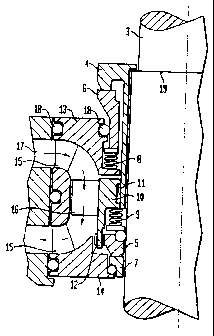Some of the information on this Web page has been provided by external sources. The Government of Canada is not responsible for the accuracy, reliability or currency of the information supplied by external sources. Users wishing to rely upon this information should consult directly with the source of the information. Content provided by external sources is not subject to official languages, privacy and accessibility requirements.
Any discrepancies in the text and image of the Claims and Abstract are due to differing posting times. Text of the Claims and Abstract are posted:
| (12) Patent: | (11) CA 2272171 |
|---|---|
| (54) English Title: | SEAL ARRANGEMENT |
| (54) French Title: | DISPOSITIF D'ETANCHEITE |
| Status: | Term Expired - Post Grant Beyond Limit |
| (51) International Patent Classification (IPC): |
|
|---|---|
| (72) Inventors : |
|
| (73) Owners : |
|
| (71) Applicants : |
|
| (74) Agent: | SMART & BIGGAR LP |
| (74) Associate agent: | |
| (45) Issued: | 2004-01-20 |
| (22) Filed Date: | 1999-05-17 |
| (41) Open to Public Inspection: | 1999-11-18 |
| Examination requested: | 1999-05-17 |
| Availability of licence: | N/A |
| Dedicated to the Public: | N/A |
| (25) Language of filing: | English |
| Patent Cooperation Treaty (PCT): | No |
|---|
| (30) Application Priority Data: | ||||||
|---|---|---|---|---|---|---|
|
The invention concerns a seal device for a submersible machine, such as a pump or a mixer. The seal device is designed as an easily replaceable unit comprising two mechanical face seals (4,6) and (5,7) resp. with an intermediate room for a barrier liquid in which a pump for circulation of said liquid is arranged. A spring housing (10) which serves as a uniting means for the seal device is provided with connecting means for the rotary seal rings (4) and (5) resp. and acts as a hub for impeller vanes (16) in said circulation pump.
L'invention concerne un dispositif de joint d'étanchéité pour une machine submersible, telle qu'une pompe ou un mélangeur. Le dispositif de joint d'étanchéité est conçu sous la forme d'une unité facilement remplaçable comprenant deux joints faciaux mécaniques (4, 6) et (5, 7) respectivement avec un espace intermédiaire pour un liquide barrière dans lequel est agencée une pompe pour la circulation dudit liquide. Un logement de ressort (10) qui sert de moyen d'unification pour le dispositif d'étanchéité est muni de moyens de raccordement pour les anneaux d'étanchéité rotatifs (4) et (5) respectivement et agit comme un moyeu pour des pales d'hélice (16) dans ladite pompe de circulation.
Note: Claims are shown in the official language in which they were submitted.
Note: Descriptions are shown in the official language in which they were submitted.

2024-08-01:As part of the Next Generation Patents (NGP) transition, the Canadian Patents Database (CPD) now contains a more detailed Event History, which replicates the Event Log of our new back-office solution.
Please note that "Inactive:" events refers to events no longer in use in our new back-office solution.
For a clearer understanding of the status of the application/patent presented on this page, the site Disclaimer , as well as the definitions for Patent , Event History , Maintenance Fee and Payment History should be consulted.
| Description | Date |
|---|---|
| Inactive: Expired (new Act pat) | 2019-05-17 |
| Change of Address or Method of Correspondence Request Received | 2018-03-28 |
| Grant by Issuance | 2004-01-20 |
| Inactive: Cover page published | 2004-01-19 |
| Inactive: Final fee received | 2003-11-04 |
| Pre-grant | 2003-11-04 |
| Notice of Allowance is Issued | 2003-10-08 |
| Letter Sent | 2003-10-08 |
| Notice of Allowance is Issued | 2003-10-08 |
| Inactive: Office letter | 2003-10-07 |
| Inactive: Delete abandonment | 2003-10-07 |
| Inactive: Correspondence - Prosecution | 2003-09-25 |
| Inactive: Abandoned - No reply to s.30(2) Rules requisition | 2003-07-08 |
| Inactive: Approved for allowance (AFA) | 2003-04-30 |
| Amendment Received - Voluntary Amendment | 2003-03-17 |
| Inactive: S.30(2) Rules - Examiner requisition | 2003-01-08 |
| Amendment Received - Voluntary Amendment | 2002-06-10 |
| Application Published (Open to Public Inspection) | 1999-11-18 |
| Inactive: Cover page published | 1999-11-17 |
| Inactive: IPC assigned | 1999-07-02 |
| Inactive: First IPC assigned | 1999-07-02 |
| Inactive: IPC assigned | 1999-07-02 |
| Inactive: Filing certificate - RFE (English) | 1999-06-16 |
| Filing Requirements Determined Compliant | 1999-06-16 |
| Letter Sent | 1999-06-16 |
| Application Received - Regular National | 1999-06-16 |
| Request for Examination Requirements Determined Compliant | 1999-05-17 |
| All Requirements for Examination Determined Compliant | 1999-05-17 |
There is no abandonment history.
The last payment was received on 2003-01-30
Note : If the full payment has not been received on or before the date indicated, a further fee may be required which may be one of the following
Please refer to the CIPO Patent Fees web page to see all current fee amounts.
Note: Records showing the ownership history in alphabetical order.
| Current Owners on Record |
|---|
| ITT MANUFACTURING ENTERPRISES, INC. |
| Past Owners on Record |
|---|
| JOHAN BRATTHALL |